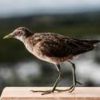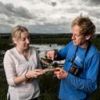
Rare bird comes to RAMM
An unusual North American joins the Royal Albert Memorial Museum & Art Gallery’s collections.
Underweight but with no sign of predation, a sora rail (Porzana carolina) was found on RSPB’s Exminster Marsh on a cold morning in October 2016. The little bird was dead: a sad end for the second recorded sora rail to visit Devon. It is 20th recorded sighting for the UK.
The sora rail was found by RSPB’s Exe Estuary Site Manager, Peter Otley, during a regular high-tide bird count. There are 5 species of rail living in the UK: coots and moorhens are very common, the corncrake, spotted crake and water rail are all less common, secretive and elusive. Assistant Warden, Aaron Boughtflower, confirmed its identification: “The sora rail is most similar to the spotted crake. This is a first-winter sora which lacks the distinctive black lores of the adult [the region between the eye and bill on the side of a bird's head]. It is plain brown on its breast rather than well-marked spots of the spotted crake and has a pronounced central crown stripe and plain tertial [flight] feathers. It is most likely to have been forced off its normal north-south migration route between northern and central America by westerly weather systems bringing it to Devon.”
Ethical taxidermist Jazmine Miles-Long prepared the specimen for display and discovered that the bird is female. Jazmine only works with animals that have died from natural causes. Visit RAMM’s Collections Explorer to see videos of Jazmine making the mount. The laborious process of washing and drying the skin, making the body, assembling the mount, preening and painting is condensed to just 4 minutes.
Just five miles from Exeter city centre, Exminster and Powderham Marshes are great places to see birds all year-round. Big flocks of geese, ducks and waders come on their migration and to spend the winter. It is also one of the last places in south-west England where lapwings and redshanks still nest.
Peter Otley said: "It has been an amazing opportunity to see the specimen come back to its former beauty. When we realised the importance of the bird, only the second time it has been recorded in Devon, the amazing displays that RAMM arranges immediately sprang to mind and we made contact with them to see if they would like to add it to their collection. We're really looking forward to seeing it on display."
The specimen will be on display in Viewpoint throughout September.
RAMM already had 15 sora rail specimens from their usual home in North America, where the bird is common on freshwater marshes, but this is RAMM’s first UK specimen. There are just 3 other specimens of sora rail found in UK museum collections.
RAMM has nearly 13,000 bird skins, mounts, skeletons, eggs and nests in its collection. The In Fine Feather gallery displays a selection that shows their immense diversity and global distribution. The fifth-largest collection outside Britain’s national museums, it includes many of the UK’s resident species and a selection of rarer visitors, like the only known UK record of the greater black-headed gull and the first European sighting of a yellow-rumped warbler found in Newton St Cyres.
Images
Main image: RSPB’s Peter Otley and RAMM’s Holly Morgenroth with the sora rail at Exminster Marshes.
Supplementary images: Peter Otley and Holly Morgenroth at the Exminster Marshes. The mounted sora rail. RSPB’s Aaron Boughtflower showing Holly the sora’s identifying characteristics.
















